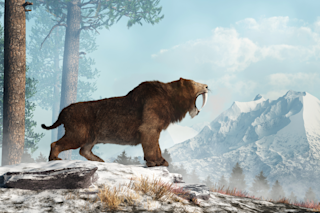One of the major challenges to studying extinct carnivores is that there are simply less of them, explains Vanderbilt University paleontologist and paleoecologist Larisa DeSantis. Trophic levels — the different levels in an ecosystem, from primary producers to apex predators — shrink the higher up they are in the energy pyramid because energy is lost as heat at each level.
“If you go outside today,” she says, “you're more likely to see grass and trees than you are to see deer, and you're more likely to see deer than you are to see coyotes.”
But at Rancho La Brea, better known as the La Brea Tar Pits, the situation is reversed. When the tar seep trapped prehistoric herbivores, that in turn attracted carnivores, says DeSantis, who grew up in Los Angeles with the site practically in her backyard.
Those carnivores included Smilodon, better known as the saber-toothed tiger — and ...














